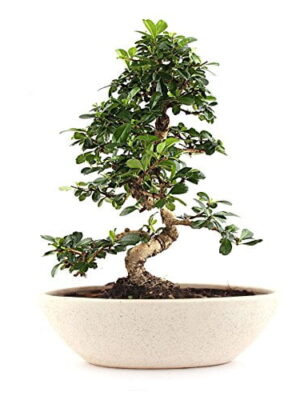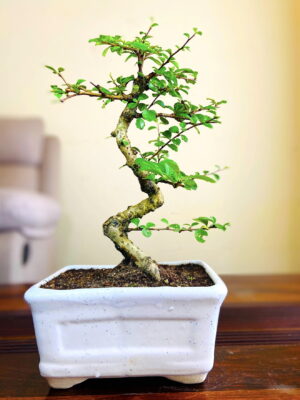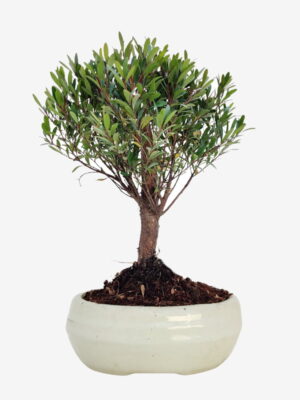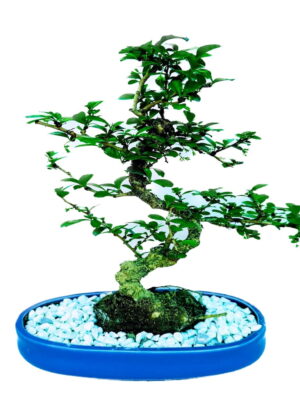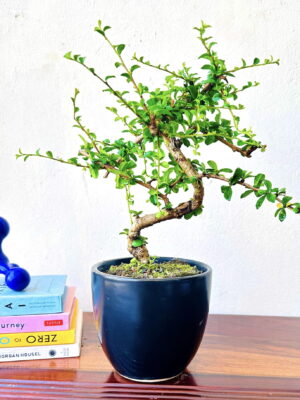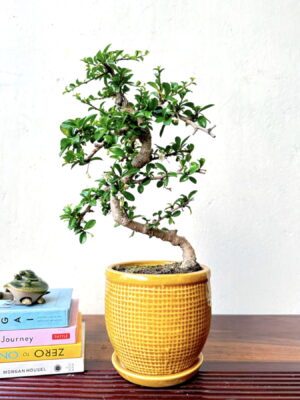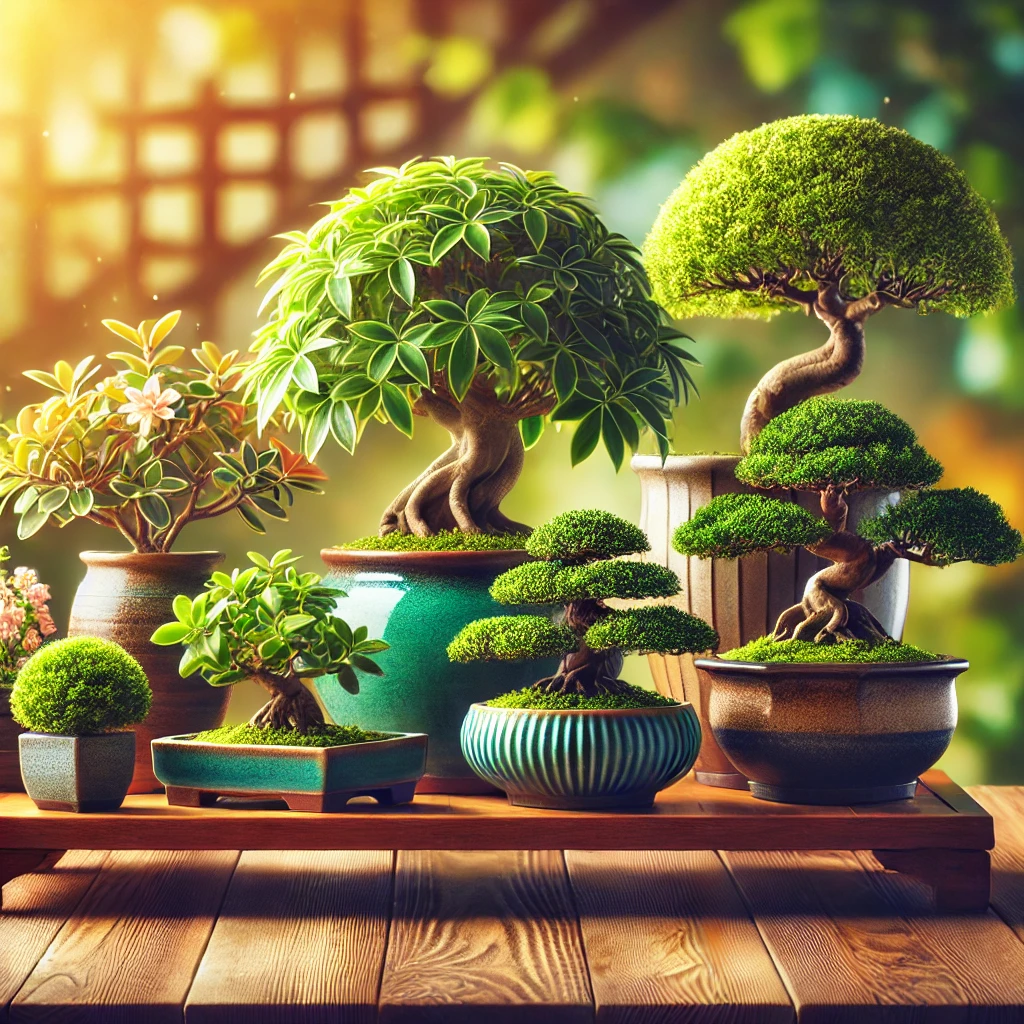Flowering Bonsai Plants
Bonsai trees with flowers provide a special touch to any space. What’s more attractive than the flower bonsai plants? These have a lovely charm in their appealing root systems and exquisite blossoms. They are a perfect addition to any interior of the house, the kitchen, or the terrace. Large plants aren’t feasible in compact spaces, so having them is ideal. Most blooming bonsai tree species can be styled and pruned in the same way as other bonsai tree species, and they’re also simple to maintain.

Showing all 12 resultsSorted by popularity
-
Bonsai Plants for Sale Online in India, Carmona Bonsai Plants, Flowering Bonsai Plants, Indoor Bonsai Tree
MRP: Original price was: ₹2,100.00.₹1,499.00Current price is: ₹1,499.00.Add to cart -
Bonsai Plants for Sale Online in India, Flowering Bonsai Plants
MRP: Original price was: ₹1,800.00.₹1,199.00Current price is: ₹1,199.00.Add to cart -
Bonsai Plants for Sale Online in India, Carmona Bonsai Plants, Flowering Bonsai Plants, Indoor Bonsai Tree
MRP: Original price was: ₹2,100.00.₹1,499.00Current price is: ₹1,499.00.Add to cart -
Bonsai Plants for Sale Online in India, Carmona Bonsai Plants, Flowering Bonsai Plants, Indoor Bonsai Tree
MRP: Original price was: ₹5,500.00.₹3,899.00Current price is: ₹3,899.00.Add to cart -
Indoor Plants, Bonsai Plants for Sale Online in India, Carmona Bonsai Plants, Flowering Bonsai Plants, Indoor Bonsai Tree
MRP: Original price was: ₹1,800.00.₹1,299.00Current price is: ₹1,299.00.Add to cart -
Bonsai Plants for Sale Online in India, Carmona Bonsai Plants, Exotic Bonsai Plants & Trees, Flowering Bonsai Plants
MRP: Original price was: ₹4,900.00.₹3,899.00Current price is: ₹3,899.00.Add to cart -
Bonsai Plants for Sale Online in India, Carmona Bonsai Plants, Flowering Bonsai Plants, Indoor Bonsai Tree
MRP: Original price was: ₹2,000.00.₹1,399.00Current price is: ₹1,399.00.Add to cart -
Bonsai Plants for Sale Online in India, Carmona Bonsai Plants, Flowering Bonsai Plants, Indoor Bonsai Tree
MRP: Original price was: ₹1,800.00.₹1,299.00Current price is: ₹1,299.00.Add to cart
Showing all 12 resultsSorted by popularity
Best Flowering Bonsai Plants
Carmona Bonsai Plant
Carmona Bonsai is among the most valued flowering bonsai trees you can prefer for indoor planting. Among its segment, it is the only flowering bonsai that is quite elegant. It is a sturdy bonsai variety that belongs to the “Fukien Tea” family. In India, Carmona Bonsai is supplied mainly from China and Thailand. The plant requires an extra amount of light and needs to be positioned where there is indirect light for maximum hours. Moreover, the perfect temperature for the controlled growth of Carmona Bonsai is 20 degrees C.
Hibiscus Bonsai
You don’t have to live in the tropics to enjoy vibrantly colored flowers like hibiscus. When planted indoors, a hibiscus bonsai tree is likely to intrigue. These trees have flowers in a range of colors, including white, yellow, red, and purple. To keep the enormous flowers and leaves from becoming overgrown, keep an eye on them.
Desert rose Bonsai
Its thick leaves complement the gorgeous pink-red blossoms. The bulbous base of the flowering bonsai plant is used to store water during periods of drought.
Azalea Bonsai Plant
Azaleas are popular not just as backyard plants, but also as flower bonsai plants. Azaleas plants bring beautiful blooms in red, pink, and white to your space. These beauties also have lovely leaves, so you can keep things interesting even when the weather isn’t favoring your side. These are incredibly easier to mold into small shapes.
How to Care For Flowering bonsai plants
- When trimming, pruning, or repotting a plant, keep your flowering bonsai plants out of direct sunlight until it has adjusted and rejuvenated.
- It’s critical that your flowering bonsai gets enough sunlight and that the soil doesn’t dry up completely, especially when it is in the flowering stage.
- When your bonsai tree is in bloom, avoid wetting your flowers since they will fade more quickly.
- Make sure your bonsai flowering tree is away from the rain.
- When pruning your bonsai tree, keep in mind that flowering bonsai trees have different growth patterns.
- You should not cut the shoots of these flowering bonsai trees until they have flowered if you want them to develop.
- Flowering Bonsai trees that are about to undergo dormancy require less water.
- Block the drainage holes at the bottom of the pot while repotting your flower bonsai plants.
How to Grow Bonsai Flower Plants
Watering schedule:
The general rule is to water when the topsoil appears to be dry. The easiest way to test for moisture is to use your finger. You need to water your flowering bonsai if the soil seems dry.
Sunlight:
Sunlight is also essential for the health and growth of your bonsai. Place them in an area that receives direct, unfiltered sunlight. Between the bonsai and the sunlight, there should be no curtains or shades.
Soil:
We recommend you to use the bonsai potting soil is special, as it has everything your bonsai needs to grow. Its components help water to drain while keeping the bonsai at the proper moisture level.
FAQs About Flowering Bonsai Trees
Ques1: Can I grow my flower bonsai plants indoors?
Yes, you can grow flowering bonsai plants indoors, but they must be cared for.
Ques2: Is it possible to grow flowering plants in pots?
Yes, almost any flower can flourish well in pots or containers.
Ques3: How do I look after flowering plants?
Giving your flowering plant ample water and frequent sunlight, as well as keeping an eye on your flowering bonsai plants for maintenance, can help them thrive well.
Ques4: Is it possible to repot the flowering bonsai Plant?
After flowering or in the spring, you can repot your flower bonsai plants every two years. Though, it also depends upon the variety and species you are growing. Once your bonsai outgrows the existing pot or container, you can repot your bonsai plant. Because the roots are tangled and thin, while repotting, a slight pruning will help. You should do it with caution. The roots are delicate. When you try to untangle them, they can easily tear.
Ques 5: What sizes do flowering bonsai trees come in?
Miniature, small-size, medium-size, and average-size flowering bonsai are the four main sizes available.
Ques6: How do I grow a blossoming bonsai?
Flowering bonsai trees can be grown from seeds, cuttings, young trees, or even repotting a small tree.
Ques7: What makes bonsai so expensive?
Bonsai is a little pricey because they take a long time to grow. Bonsais require work to create. Proper styling and training are required to create the desired bonsai shape. A bonsai flowering plant looks like a miniature tree in a pot even after ten years of care.
Ques8: Can I gift flowering bonsai plants over flowers to my loved ones?
Flower bonsai plants are a great alternative to flowers. They are the perfect pick if you are looking for a distinctive, creative, and long-lasting gift. Every time they care for or look after their bonsai, they will remember you!
Ques9: Why should I purchase a home from Abana Homes?
Abana Homes prioritizes your happiness with our Indoor Bonsai Plants by providing only healthy plants that have been cared for by professional Bonsai artists. Every bonsai plant that arrives at your home comes with detailed instructions for keeping your Bonsai Tree healthy and happy for a long time.
Ques10: Do I need to prune my flowering bonsai plants frequently?
You probably won’t need to prune your flowering bonsai tree for a long time if you just bought it. Trim or prune only if you want to mold the plant into a particular shape. You can prune your bonsai plants later to remove thicker or overgrown branches if necessary.
Pruning is also necessary if you observe that the tree’s roots or limbs have become stunted or sick-looking as a result of the abundance of blossoms. Make sure the flowers are evenly spaced on the plant and are of similar size. The optimal time to prune is usually in the fall or early spring before new growth emerges.
Ques 11. What are the different sizes of flowering bonsai trees?
Ans: The four different sizes of flowering bonsai include the miniature, small-size, medium-size, and the average size.
Ques 12. How to plant a flowering bonsai?
Ans: You can plant flowering bonsai trees from seeds, cuttings, young trees and even by repotting a stunted tree.
Other Flowering Bonsai Plants
Glabra Bougainvillea
These bonsai shrubs come in a variety of colors, including pink, yellow, and white. You can clip and train Glabra Bougainvillea’s vine-like woody branches into a bonsai on a regular basis to keep its size in check.
West Indian Jasmine
Who isn’t familiar with the fragrance of Jasmine? With regular hydration, plenty of bright light, and the occasional pruning, you can easily adapt it as a flower bonsai plant.
Wisteria Bonsai Plant
Wisteria plants, also known as Wisteria Sinensis, grow in various places, including Europe, Asia, and the United States. Wisteria bonsai trees, which are really shrubs, produce beautiful purple flowers that you’ll enjoy. The only con is that you’ll have to wait a long time for your bonsai to bloom, as they take several years to do so.
Magnolia Star
The main elements of star magnolia flower bonsai plants include thin twigs, glossy leaves, and magnificent blossoms. You can enjoy the strong aroma of the blooms throughout the day if you keep it in an open window.
Crabapples
Crabapples are known for their pink blooms that bloom in the springtime, in addition to their tasty fruits. These flower bonsai plants have glossy, alternating leaves that go well with the pink-red flowers.
Golden Shower tree
It is Kerela’s state flower, and its bonsai form is greatly sought after in South India. Similar to its name, it showers people with its vivid yellow flowers from spring until summer.
Sasanqua Camellia
Sasanqua Camellia is ideal for small places. Because of their tiny stature and slow growth, you can place these flower bonsai plants on tabletops and living rooms. It has semi-double crimson blooms that offer a splash of color to the winter landscape.

